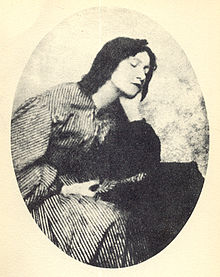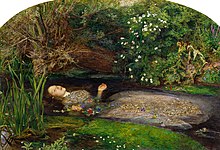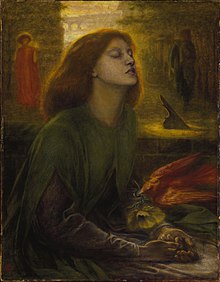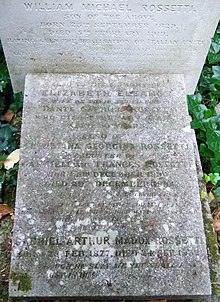Elizabeth Siddal
Elizabeth Siddall | |
|---|---|
 Elizabeth Siddall, circa 1860 | |
| Born | 25 July 1829 London, England |
| Died | 11 February 1862 (aged 32) London, England |
| Occupation | artist, poet, artist's model |
| Spouse(s) | Dante Gabriel Rossetti |
| Parent(s) | Charles Crooke Siddall and Elizabeth Eleanor Siddall (née Evans) |
Elizabeth Eleanor Siddall (25 July 1829 – 11 February 1862), styled and commonly known as Lizzie,[1] was an English artist, poet, and artists' model. (Her surname was shortened to Siddal after her marriage to Dante Gabriel Rossetti.) Siddall was an important and influential artist and poet. Significant collections of her artworks can be found at Wightwick Manor and the Ashmolean. Siddall was painted and drawn extensively by artists of the Pre-Raphaelite Brotherhood, including Walter Deverell, William Holman Hunt, John Everett Millais (including his notable 1852 painting Ophelia), and her husband, Dante Gabriel Rossetti.
Early life[]
Elizabeth Eleanor Siddall, named after her mother, was born on 25 July 1829, at the family's home at 7 Charles Street, Hatton Garden. Her parents were Charles Crooke Siddall, and Elizabeth Eleanor Evans, from a family of English and Welsh descent. At the time of her birth, her father had a cutlery-making business, but around 1831, her family moved to the borough of Southwark, in south London, a less salubrious area than Hatton Garden. She had two older siblings, Ann and Charles Robert. The rest of Siddall's siblings were born in Southwark; Lydia, to whom she was particularly close; Mary, Clara, James and Henry. Although there is no record of Elizabeth Siddall having attended school, she could read and write, presumably having been taught by her parents. She developed a love of poetry at a young age, after discovering a poem by Tennyson, which served as inspiration to start writing her own poems.
Model for the Pre-Raphaelites[]
Siddall showed her own drawings to Walter Deverell's father in 1849, while she was working at a dressmakers and millinery shop in Cranbourne Alley, London. Deverell's father suggested that she should model for Walter. She was employed as a model by Deverell and through him was introduced to the Pre-Raphaelites.[2]
Though she was later touted for her beauty, Siddall was originally chosen as a model because of her plainness. At the time, Deverell was working on a large oil painting depicting a scene from Twelfth Night, showing Orsino, Feste, and Viola as Cesario. Like the rest of the Pre-Raphaelites, Deverell took his inspiration and forms from life rather than from an idealized or antique figure. He based his Orsino on himself, Feste on his friend Dante Rossetti. This was the first painting for which Siddall sat.[3]

While posing for Millais's Ophelia in 1852, Siddall floated in a bathtub full of water to represent the drowning Ophelia. Millais painted daily through the winter, putting oil lamps under the tub to warm the water. On one occasion the lamps went out and the water became icy cold. Millais, absorbed by his painting, did not notice and Siddall did not complain. After this she became very ill with a severe cold or pneumonia. Her father held Millais responsible and, under the threat of legal action, Millais paid her doctor's bills.
Elizabeth Siddall was the primary model and muse for Dante Gabriel Rossetti throughout most of his youth. Rossetti met her in 1849, when she was modelling for Deverell. By 1851, she was sitting for Rossetti and he began to paint her to the exclusion of almost all other models. Rossetti also stopped her from modelling for the other Pre-Raphaelites. The number of paintings and drawings he did of her are said to number in the thousands.[4] Perhaps best known among Rossetti's works from Siddall is Beata Beatrix, which depicts a praying Beatrice (from Dante Alighieri) and was painted in 1863, a year after Siddall's death.
Work[]

In 1852, Siddall began to study with Rossetti. She also painted a self-portrait, which differs from the idealised beauty portrayed by the Pre-Raphaelites. In 1855, art critic John Ruskin began to subsidise her career and paid £150 per year in exchange for all the drawings and paintings she produced. She produced many sketches, drawings, and watercolours as well as one oil painting. Her sketches are laid out in a fashion similar to Pre-Raphaelite compositions illustrating Arthurian legend and other idealized medieval themes, and she exhibited with the Pre-Raphaelites at the summer exhibition at Russell Place in 1857.[5]
During this period Siddall also began to write poetry, often with dark themes about lost love or the impossibility of true love. "Her verses were as simple and moving as ancient ballads; her drawings were as genuine in their medieval spirit as much more highly finished and competent works of Pre-Raphaelite art," wrote critic William Gaunt.[6] Both Rossetti and Ford Madox Brown supported and admired her work.
A 2018 exhibition, entitled "Beyond Ophelia", curated by National Trust Assistant Curator Hannah Squire, ran at Wightwick Manor for nine months and featured twelve artworks created by Siddall and owned by the National Trust. Only the second solo exhibition of her work (the first was curated by Dr. Jan Marsh at the Ruskin Gallery, Sheffield in 1991), the exhibition examined Siddall's career, artistic style, subject matter, and the prejudice she faced as a female artist, whilst also exploring the Manders of Wightwick as pioneering collectors: Rosalie Glynn Grylls and Geoffrey Mander paid a record sum for her work in the 1960s and gave the art to the National Trust, for everyone to appreciate.

Marriage to Rossetti and Relationship with Rossetti's Family[]
This section needs additional citations for verification. (January 2015) |
Siddall and Rossetti married on Wednesday, 23 May 1860 at St. Clement's Church in the seaside town of Hastings. There were no family or friends present, just a couple of witnesses whom they had asked in Hastings.
Beginning in 1853 with a watercolour The First Anniversary of the Death of Beatrice, Siddall sat for many of Rossetti's works. After this work, Rossetti used Siddall in other Dante-related pieces, including Dante's Vision of Rachel and Leah (1855), Beatrice Meeting Dante at a Marriage Feast, Denies him her Salutation (1851), and Beata Beatrix (1864–1870), which he painted as a memorial after her death. Perhaps Rossetti's most abundant and personal works were pencil sketches of Siddall at home, which he began in 1852 when she moved into Chatham Place with him.



When the two moved in together, they became increasingly anti-social and absorbed in each other's affections. The lovers coined affectionate nicknames for one another, which included "Guggums" or "Gug" and "Dove" – one of Rossetti's names for Siddall. He also changed the spelling of her name to Siddal, dropping the second 'l'. Siddall was repeatedly idealized in Rossetti's sketches, most of which he entitled simply "Elizabeth Siddal." In these sketches, Siddall was portrayed as a woman of leisure, class, and beauty, often situated in comfortable settings. Rossetti's poem A Last Confession exemplifies his love for Siddall, whom he personifies as the heroine with eyes "as of the sea and sky on a grey day."[7]

Another famous portrait of Siddall produced by Rossetti towards the end of their marriage was Regina Cordium or The Queen of Hearts (1860). Painted as a marriage portrait, this painting shows a close-up, vibrantly coloured depiction of Siddall.[7]
As Siddall came from a working-class family, Rossetti feared introducing her to his parents. Siddall was the victim of harsh criticism from his sisters. Knowledge that his family would not approve the marriage contributed to Rossetti putting it off. Siddall appears to have believed, with some justification, that Rossetti was always seeking to replace her with a younger muse, which contributed to her later depressive periods and illness.
Seven years after his wife's death, Rossetti published a collection of sonnets entitled The House of Life; contained within it was the poem, "Without Her." It is a reflection on life once love has departed:
What of her glass without her? The blank grey
There where the pool is blind of the moon's face.
Her dress without her? The tossed empty space
Of cloud-rack whence the moon has passed away.
Her paths without her? Day's appointed sway
Usurped by desolate night. Her pillowed place
Without her? Tears, ah me! For love's good grace,
And cold forgetfulness of night or day.
What of the heart without her? Nay, poor heart,
Of thee what word remains ere speech be still?
A wayfarer by barren ways and chill,
Steep ways and weary, without her thou art,
Where the long cloud, the long wood's counterpart,
Sheds doubled up darkness up the labouring hill.
Ill health and death[]

Siddall travelled to Paris and Nice for several years for her health. At the time of her wedding, she was so frail and ill that she had to be carried to the church, despite it being a five-minute walk from where she was staying. It was thought that she suffered from tuberculosis, but some historians believe an intestinal disorder was more likely. Others have suggested she might have been anorexic while others attribute her poor health to an addiction to laudanum or a combination of ailments.[8] She became severely depressed and her long illness gave her access to laudanum to which she became addicted. In 1861, Siddall became pregnant, which ended with the birth of a stillborn daughter. The death of her child left Siddall with a post-partum depression. She became pregnant for a second time in late 1861.
Siddall overdosed on laudanum in February 1862. Rossetti discovered her unconscious and lying in bed after having had dinner with her and his friend Algernon Charles Swinburne. After having taken Siddall home, Rossetti attended his usual teaching job at the Working Men's College. Once Rossetti returned home from teaching, he found Siddall unconscious and was unable to revive her. The first doctor Rossetti called claimed to be unable to save her, upon which Rossetti sent for another three doctors. A stomach pump was used, but to no avail. She died at 7.20 a.m. on 11 February 1862 at their home at 14 Chatham Place, now demolished and covered by Blackfriars Station. Although her death was ruled accidental by the coroner, there are suggestions that Rossetti found a suicide note, with the words "Please look after Harry" (her invalid brother, who may have had a slight intellectual disability), supposedly "pinned ... on the breast of her night-shirt."[9][10] Consumed with grief and guilt Rossetti went to see Ford Madox Brown who is supposed to have instructed him to burn the note, since suicide was illegal, immoral, would have brought scandal on the family and barred Siddall from a Christian burial.
She was buried with her father-in-law Gabriele on the 17th February in the Rossetti family grave in the west side of Highgate Cemetery. Seven years later, in October 1869 her coffin was opened by her husband's wish and a handwritten book of his poems, laid beside her at death, was removed. These he published in Poems (1870).[11]
Later burials in the same grave are her mother-in-law Frances Rossetti (1886), Christina Georgina Rossetti (1895) and William Michael Rossetti (1919). The ashes of four grandchildren have also been buried in the grave subsequently.
In fiction, drama, and song[]

Rossetti's relationship with Siddall has been the subject of television dramas, notably Dante's Inferno (1967), by Ken Russell, in which she was played by Judith Paris and Rossetti by Oliver Reed; The Love School (1975) in which she was played by Patricia Quinn; and Desperate Romantics (2009) in which she was played by Amy Manson.
Mollie Hardwick (author of Upstairs, Downstairs) wrote a mystery novel entitled in 1990.[13] The plot follows antique dealer Doran Fairweather, who is elated to find a small oil painting she believes to be of Elizabeth Siddall but is shocked when she happens on the body of a girl, floating dead in a pond. The death scene mimics the Millais painting of Ophelia featuring Elizabeth Siddall. Doran' excited by the coincidence and mystery, ignores the advice of her husband who warns her the story of Rossetti and Siddall was plagued by unhappiness.[14]
In Tim Powers' 2012 novel , Siddall is a victim of the vampire John Polidori, her husband's uncle and author of what is likely the first vampire story. This becomes an explanation for her illness and death, as well as for her husband's exhumation of her grave, which is not to regain his poems but is part of a strategy to defeat the vampire.[15]
Ghostland is a 2001 album by the Seattle neo-psychedelic band named after a poem by Christina Rossetti, and the album is inspired by the exhumation of Elizabeth Siddall.
Elizabeth Siddall, Dante Gabriel Rossetti, and Algernon Charles Swinburne are the subjects of the short comics story , by Neil Gaiman, drawn by Michael Zulli, and published in Vertigo: Winter's Edge #3 (2000). The title makes reference to the . In it, a dying Elizabeth drugged with laudanum revives the last New Year's Day, in which the trio had a train trip to a magic forest owned by Desire, the androgynous sibling of Sandman.[16]
Lizzie Siddal, a play written by Jeremy Green, was performed at the Arcola Theatre, London in 2013.[17]
Ophelia's Muse, a work of art historical fiction by Rita Cameron that was published in September 2015 by Kensington Press, tells the story of Siddall and the Pre-Raphelites.
Sleep, Pale Sister, a Gothic novel set in the Victorian art world by the author Joanne Harris, draws heavily on the character of Siddall and her relationship with Rossetti, and Fiona Mountain's 2002 mystery novel, Pale as the Dead centres a "genealogical mystery" around the fictional descendants of Elizabeth Siddall and Dante Gabriel Rossetti.[18]
Murder in the Locked Library, a strange book themed murder mystery by Ellery Adams, contains a scene where a group of ladies discuss Lizzie Siddal.
Notes[]
- ^ Walker, Kirsty Stonell (2018). Pre-Raphaelite Girl Gang. Unicorn. p. 24.
- ^ Marsh, Dr Jen (19 October 2019). "Elizabeth Siddall feature at 16:45 into the programme on 19/10/2019". BBC Womans Hour.
- ^ Marsh, Jan (1985). The Pre-Raphaelite Sisterhood. New York: St. Martin's Press. ISBN 0312637381.
- ^ Hawksley 2000, p. 96.
- ^ Marsh, Jan; Gerrish Nunn, Pamela (1997). Pre-Raphaelite Women Artists. London: Thames & Hudson. p. 114.
- ^ Gaunt, William (1966). The Pre-Raphaelite Dream. New York: Schocken. p. 64. ISBN 080520119X. Retrieved 25 September 2016.
- ^ Jump up to: a b "Regina Cordium (The Queen of Hearts) By Dante Gabriel Rossetti". Birmingham Museums and Art Gallery. Retrieved 28 January 2019.
- ^ Ash 1995, pp. 4, 7.
- ^ Marsh, Jan (15 February 2012). "Did Rossetti really need to exhume his wife?". TheTLS.
- ^ Williamson, Audrey (13 October 1976). Artists and Writers in Revolt: The Pre-Raphaelites. David & Charles. p. 46. ISBN 978-0-7153-72-623 – via Google Books.
- ^ Surtees, V. Siddal, Elizabeth Eleanor (1829–1862), painter. Oxford Dictionary of National Biography. Retrieved 7 Jun. 2021, from oxforddnb.com
- ^ Harvard.
- ^ "Hardwick, M", British Crime Writers List, NL: XS4 all.
- ^ Hardwick, Mollie (1990). The Dreaming Damozel ISBN 0-8161-5323-X
- ^ Powers, Tim (2012). Hide Me Amongst the Graves ISBN 0-06-123154-1
- ^ Roeberg, Shelly, ed. (2000), "Winter's Edge", Vertigo, 3, 1700 Broadway, New York, NY 10019: DC Comics, Barcode 76194121118300311CS1 maint: location (link).
- ^ Lizzie Siddal, Arcola theatre.
- ^ Mountain 2002.
References[]
- Ash, Russell (1995), Dante Gabriel Rossetti, Harry N Abrams, ISBN 0-8109-3784-0.
- Cherry, Deborah (1993), Painting Women: Victorian Women Artists, London: Routledge, ISBN 0-415-06053-2.
- Daly, Gay (1989). Pre-Raphaelites in Love, New York: Ticknor & Fields. ISBN 0-89919-450-8.
- Gaunt, William (1966). Pre-Raphaelite Dream, Schocken Books, ASIN B000OJUC5K
- Lewis, Roger C. & Lasner, Mark Samuels (Eds.) (1978). Poems and Drawings of Elizabeth Siddall, Wolfville, Nova Scotia: The Wombat Press. ISBN 0-9690828-0-0.
- Marsh, Jan (1992), The Legend of Elizabeth Siddal, London: Quartet, ISBN 0-7043-0170-9.
- Mountain, Fiona (2002), Pale as the Dead, Signet, ISBN 0-451-21617-2.
- Prose, Francine (2003), "Elizabeth Siddal", The Lives of the Muses, London: Aurum, pp. 99–136, ISBN 1-85410-944-8.
- Hawksley, Ludinda (2000), Essential Pre-Raphaelites, London: Parragon, ISBN 1-84084-524-4.
- ——— (2004), Lizzie Siddal: The Tragedy of a Pre-Raphaelite Supermodel, London: André Deutsch, ISBN 0-233-00050-X.
- Marsh, Jan; Gerrish Nunn, Pamela (1997), Pre-Raphaelite Women Artists, London: Thames & Hudson, ISBN 0-500-28104-1.
Further reading[]
- Correia, Hélia (2010). Adoecer, in Portuguese, Relógio d'Água, Portugal ISBN 978-989-641-160-2
- Morrissey, Kim (1998). Clever as Paint: The Rossettis in Love (playscript), Toronto: Playwrights Canada Press. ISBN 0-88754-552-1.
- Shefer, Elaine (Spring-Summer 1988). "Elizabeth Siddal's 'Lady of Shalott.'" Woman's Art Journal 9, no. 1, pp. 21–29. Elizabeth Siddal's "Lady of Shalott"
- Surtees, Virginia (1991). Rossetti's Portraits of Elizabeth Siddall, Aldershot: Scolar Press. ISBN 0-85967-885-7.
External links[]
| Wikimedia Commons has media related to Elizabeth Siddal. |
- Selected Poetry of Elizabeth Siddall
- Beyond Ophelia Exhibition, Wightwick Manor, Wolverhampton
- Birmingham Museums & Art Gallery's Pre-Raphaelite Online Resource includes many portraits of Elizabeth Siddall by Rossetti
- Portraits of Elizabeth Siddal from major Rossetti exhibition
- Letters written by Elizabeth Siddal
- Photographs of Elizabeth Siddall's grave
- Works by Elizabeth Siddal at LibriVox (public domain audiobooks)

- 1829 births
- 1862 deaths
- People from Holborn
- English artists' models
- Polidori-Rossetti family
- Pre-Raphaelite Brotherhood artists' models
- Pre-Raphaelite painters
- Pre-Raphaelite Brotherhood
- Women of the Victorian era
- British women painters
- Burials at Highgate Cemetery
- Accidental deaths in England
- Drug-related deaths in England
- Victorian poets
- English women poets
- 19th-century English women writers
- 19th-century British writers
- 19th-century British women artists
- 19th-century British painters
- Muses
- Painters from London